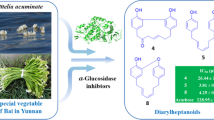One new coumaronochromone named 5,7,2′-trihydroxy-6-methoxycoumaronochromone (1), and six known compounds named benzyl-O-α-L-rhamnopyranosyl-(1→6)-β-D-glucopyranoside (2), chikusetsusaponin V (3), crotonine (4), ayamenin A (5), achyranthoside A (6), 5-hydroxypyridine-2-carboxylic acid methyl ester (7), were obtained from Achyranthes bidentata. The antihyperuricemic acid activities of these isolated compounds (1–7) were assayed by an HK-2 cell model induced by adenosine combined with xanthine oxidase. The contents of uric acid produced by the HK-2 cell model were determined by HPLC analysis. As the results show, compound 3 was the most effective and was almost in line with the positive drug of febuxostat, whereas compounds 1, 4, 5, and 6 showed moderate antihyperuricemic acid activities at a concentration of 50.0 μM.

Similar content being viewed by others
References
X. He, X. Wang, J. Fang, Y. Chang, N. Ning, H. Guo, L. Huang, and X. Huang, J. Ethnopharmacol., 203, 260 (2017).
S. R. Li and H. R. Dong, Chem. Nat. Compd., 43, 635 (2007).
J. Fu, H. Wu, H. Wu, R. Deng, and M. Sun, J. Ethnopharmacol., 274, 114067 (2021).
Y. Shi, Z. W. Zhang, M. M. Du, J. Wu, and J. X. Li, J. Ethnopharmacol., 312, 116458 (2023).
D. Song, Z. Cao, S. Huang, J. Tickner, N. Li, H. Qiu, X. Chen, C. Wang, K. Chen, Y. Sun, S. Dong, and J. Xu, J. Cell Biochem., 119, 4826 (2018).
Y. Ju, H. Liang, K. Du, Z. Guo, and D. Meng, Nat. Prod. Res., 35, 5939 (2021).
S. M. Guo, X. P. Che, and X. W. Fan, J. Xian Med. Univ., 18, 216 (1997).
Y. Jiang, Y. Zhang, W. Chen, C. F. Liu, X. M. Li, D. N. Sun, Z. L. Liu, Y. Xu, X. Mao, Q. Y. Guo, and N. Lin, J. Transl. Med., 19, 208 (2021).
L. W. Lin, F. H. Tsai, W. C. Lan, Y. D. Cheng, C. L. Sheng, and R. W. Chi, Mol. Neurobiol., 56, 5671 (2019).
J. Wu, J. Y. Li, W. Li, B. Sun, J. Xie, W. M. Cheng, and Q. L. Zhang, J. Ethnopharmacol., 221, 100 (2018).
T. Niu, J. Q. Yu, Z. Q.Wang, C. C. Wang, Y. J. Guo, J. Li, and X. Wang, J. Sep. Sci., 47, 2300901 (2024).
J. H. Chai, Y. T. He, S. L. Jiang, X. H. Zhu, Q. Y. Zhang, M. H. Ji, J. Liang, and Y. G. Xia, J. Pharm. Pharmacol., 76, 307 (2024).
B. X. Shan, T. Chen, B. X. Huang, Y. Liu, and J. Chen, J. Ethnopharmacol., 281, 114545 (2021).
Y. S. Kim, J. M. Cha, D. H. Kim, T. H. Lee, and K. R. Lee, Nat. Prod. Sci., 24, 54 (2018).
D. L. Meng, X. Li, Y. H. Xiong, and J. H. Wang, J. Shenyang Pharm. Univ., 19, 27 (2002).
X. A. Wu, Y. M. Zhao, and N. J. Yu, J. Asian Nat. Prod. Res., 9, 437 (2007).
Y. H. Zhou, K. X. Zhan, B. Gong, L. Zhang, C. Wang, and Y. S. Li, J. Asian Nat. Prod. Res., 29, 753 (2012).
Y. Li, J. Chi, P. Wang, and Z. Wang, Rec. Nat. Prod., 16, 110 (2022).
Z. F. Li, Q. Wang, Y. L. Feng, Y. Rao, S. L. Yang, and Y. H. Pei, Chin. Herb. Med., 43, 1273 (2012).
Z. Q. Wang, J. Q. Yu, L. Zhao, T. Niu, and X. Wang, J. Sep. Sci., 47, 2300741 (2024).
Acknowledgment
This work was supported by the Key R&D Program of Shandong Province, China (2021ZDSYS12), China Agriculture Research System of MOF and MARA (CARS-21), and National Science & Technology Fundamental Resources Investigation Program of China (2018FY100700).
Author information
Authors and Affiliations
Corresponding author
Additional information
Published in Khimiya Prirodnykh Soedinenii, No. 1, January–February, 2025, pp. 49–51.
Rights and permissions
Springer Nature or its licensor (e.g. a society or other partner) holds exclusive rights to this article under a publishing agreement with the author(s) or other rightsholder(s); author self-archiving of the accepted manuscript version of this article is solely governed by the terms of such publishing agreement and applicable law.
About this article
Cite this article
Yu, J., Wang, X., Botirov, E.K. et al. Chemical Constituents from Achyranthes bidentata and Their Antihyperuricemic Acid Activities. Chem Nat Compd 61, 52–55 (2025). https://doi.org/10.1007/s10600-025-04572-y
Received:
Published:
Issue Date:
DOI: https://doi.org/10.1007/s10600-025-04572-y




